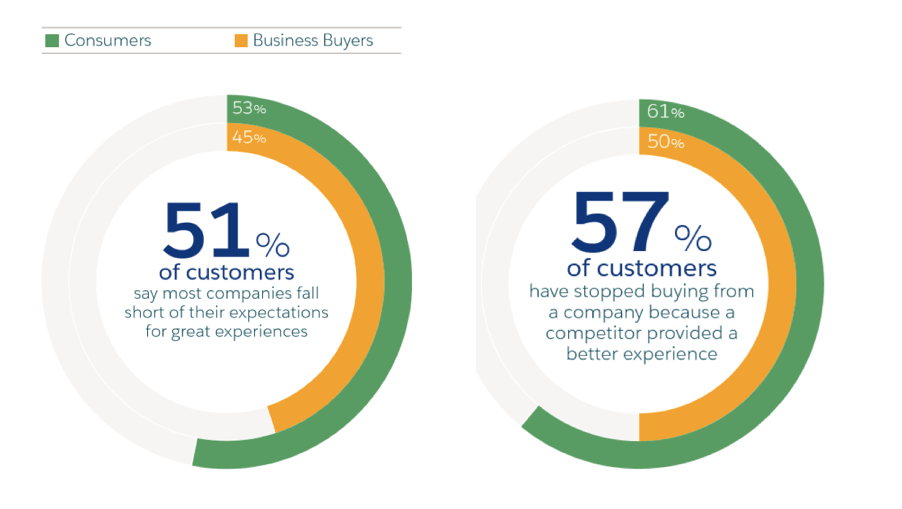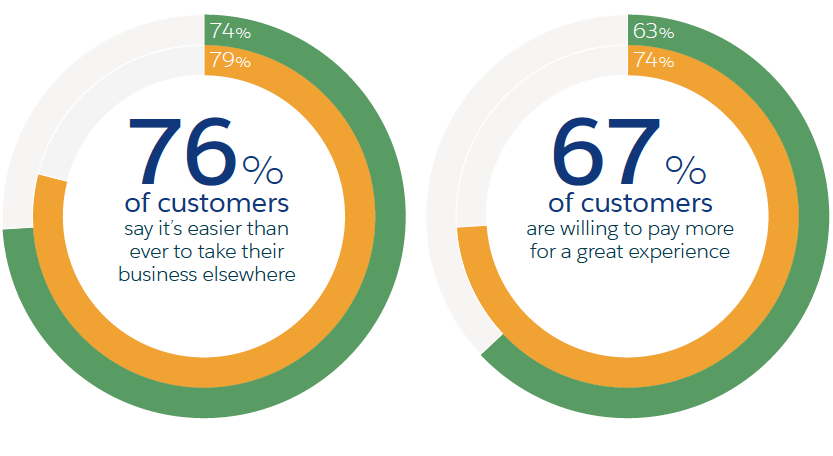If Customer Centricity Is So Important, Why Do So Many Businesses Struggle to Get It Right?
Customer centricity has never been more important to the success of both B2B and B2C companies. In just a few clicks, today’s customers have the power to shop around for the best price, compare features and even consult customer and influencer testimonials. The shift in power over the last decade is pronounced. Customers may have always known that they have options, but today, they know how to find those options with ease and speed.
As a result, customer loyalty is more fluid than it has been in the past. Customers need more than tangible features to feel satisfied with a company’s product/service; they also expect an intangible customer experience that makes them feel appreciated, understood and valued.
With product/brand preference being driven by customer experience, many Fortune 1000 company leaders are quick to express a real passion for customer centricity.
Here’s the Unfortunate Truth
That expressed passion from company leaders, more times than not, fails to turn into an effective experience a consumer can see or feel. Just look at the research from Salesforce’s “State of the Connected Customer” report.

Source: 2nd Edition, State of the Connected Customer, Salesforce Research 2018
Even companies with an undeniable passion for being customer-centric, can fall down when it comes to online and offline implementation. Take a look at the scorecard below based on my own recent experience with Southwest – a company known for being customer-centric.
The series of events outlined below occurred when my flight to a special event was canceled along with hundreds of flights on the East Coast due to severe storms. While I didn’t make it to my destination, my checked bag did and it took 3 days to get it back.
As a customer living through this series of ups and downs, I can tell you it’s an experience I won’t forget (mostly for all the wrong reasons). As a professional Strategy Consultant, once the sting of the situation wore off, I started to think about the lack of data connections, the absence of a contact strategy checklist and the missed opportunity for Southwest to ask me about my experience after the fact.
Why didn’t the Agent at the airport show me a bit of compassion? Why didn’t the email marketing automation system run a cross-check with my flight information to stop the inappropriate cross-sell email I received? Why didn’t I receive an email to update me on the status of my missing bag or one to tell me that it was in route? Where was the system trigger to have someone call me when my bag arrived at my local airport?
A desire to be customer-centric doesn’t readily translate into real-world online and offline implementation. It requires a continuous, ongoing effort coordinating with many teams within your organization. Here are a few steps we execute with our clients…
Five Key Steps to Implement an Effective Customer-centric Experience
-
Always ask your customers about their experience and never stop listening
The closer you can remain to understanding customer needs, the better positioned you are to address them. Ethnographic surveys to potential customers, as well as surveys to existing customers, are a key step in gaining the customer’s perspective. Digital intelligence (digital listening) is also a good ongoing means of keeping an ear to the ground for customer feedback.
-
Run a regular audit of your Marketing, Sales and Operations data
Often times patterns in customer data can reveal things you might not have known, or validate what you and your team may have suspected. How are they using your website? How long between the first-time they talk to a Sale Representative to the next time they call back to make a purchase? At what point in their lifecycle do they sign up for a loyalty program? How long before they upsell? Etc.
Overcoming 3 Barriers to Create a Data-Driven Sales Culture
We’ve seen three common barriers that impede the successful adoption of data-driven insights by your sales …
Read More -
Conduct ongoing discovery of your Marketing, Sales and Operations processes to uncover what’s working and what’s not
Your teams are working through real-world processes daily, so they know the pain points that impact the customer, and more importantly, they know why. Too often if a pain point goes unresolved, the reason is that certain teams typically don’t have the authority, time or resources to address the issue. Identifying those issues in discovery allows you to actively address them.
-
Identify the opportunities/barriers and document a long-term/short-term implementation roadmap
By reviewing your findings from #1, #2 and #3, you’ll not only have a host of data, but also context from the customer’s point-of-view. Together you’ll be able to rank by ease and by business impact which opportunities to pursue/which barriers to overcome first.
-
Assign an internal team or hire an external team accountable for showing time-bound progress against the implementation roadmap
Once you’ve prioritized where to get started on your implementation roadmap, you need a dedicated team to get it done. The keyword is dedicated. Most of the time your existing teams are busy crushing it in their existing jobs and adding one more To-Do to their plate is apt to have a negative effect – meaning something will unintentionally suffer. Too often, it’s the customer experience touchpoints that get cut.
Let’s Talk About the HiPPO In the Room. Five Steps to Activate Data-Driven Sales and Marketing
Increasing Data and Analytics Usage is the #1 Marketing and Sales Priority for B2B …
Read More
The Customer Experience Payoff
If driving effective implementation of a customer-centric experience sounds like a lot of effort, it is. But when it’s done well, your company will see the results in the form of an improved Customer Lifetime Value (CLV), and even overall revenue.
I’ll leave you to ponder the final two stats from Salesforce below. Your customer clearly cares about a great customer experience. The question now is are you ready to do something more about it.

Source: 2nd Edition, State of the Connected Customer, Salesforce Research 2018






